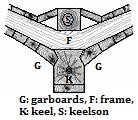Strake
This article needs additional citations for verification. (November 2017) |

A strake is a course of the planking or plating of the hull of a vessel. In a wooden construction it is a strip of planking (or multiple planks combined into one) running longitudinally along the vessel's bottom and sides. In a metal ship it is a course of plating.
Strakes are fastened to the bow at its stem at the front of a ship and stern at its transom at its rear.
Strake names

In boat and ship construction the strake immediately adjacent to either side of the keel is known as the garboard strake or A strake. The next two are the first broad or B strake and second broad or C strake. Working upward come the bottom strakes, lowers, bilge strakes, topside strakes, and uppers also named sequentially as the D strake, E strake, etc. The uppermost along the topsides is called the sheer strake.[1] Strakes are joined to the stem by their hood ends.[2]
A rubbing strake was traditionally built in just below a carvel sheer strake. It was much less broad but thicker than other strakes so that it projected and took any rubbing against piers or other boats when the boat was in use. In clinker boats, the rubbing strake was applied to the outside of the sheer strake. Many current pleasure craft reflect this history in that they have a mechanically attached (and therefore replaceable) rub rail at the location formerly occupied by a rubbing strake, often doubling to cover the joint between a GRP hull and its innerliner.
A stealer is a short strake employed to reduce the width of plank required where the girth of the hull increases or to accommodate a tuck in the shape. It is commonly employed in carvel and iron/steel shipbuilding, but very few clinker craft use them.
Construction
In very small boats strakes can be made of one continuous piece of wood. In larger wood vessels they usually are made of more than one plank and scarfed or butt joined and backed up with a butt block. Where the transverse sections of the vessel's shape are fuller, the strakes are wider. They taper toward the ends.
In a riveted steel ship, the strakes were usually lapped and joggled, but where a smoother finish was sought they might be riveted on a butt strap, though this was weaker. In modern welded construction, the plates are normally butt-welded with full penetration welds all round to adjoining plates within the strake and to adjoining strakes.
Sources
- ^ Principles of Naval Engineering. Washington, D.C.: United States Government Publishing Office. 1970. p. 19.
- ^ General wooden boat information
